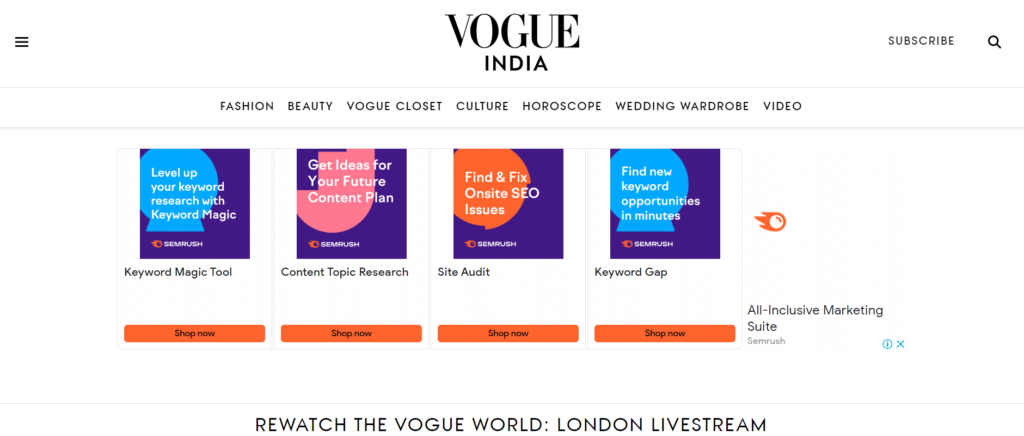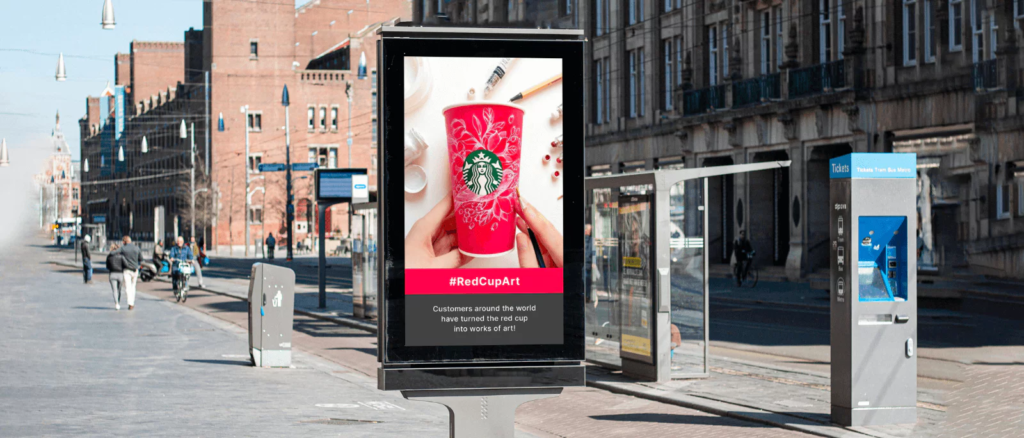Programmatic advertising has become ubiquitous, permeating various media channels. You can encounter it during your routine podcast listening or while watching YouTube videos.
Additionally, these advertisements make frequent appearances when you scroll through your social media feeds, visit websites, or peruse magazines and newspapers.
This advertising approach enjoys significant popularity among brands for valid reasons. Instead of the laborious process of manually identifying and contacting publishers, brands can leverage programmatic advertising to effortlessly disseminate their ads across a network of publishers without the need for individual outreach.
We will explore its functioning and provide you with insights on how to initiate your journey into programmatic advertising.
- What is Programmatic Advertising?
- Benefits and Challenges
- The Basics of Programmatic Marketing
- How does Programmatic Advertising Work?
- What is the Cost of Programmatic Advertising?
- Best Programmatic Advertising Platforms
- Types of Programmatic Advertising
- Best Practices for Successful Programmatic Campaigns
- Performance Future Outlook of Programmatic Advertising
What is Programmatic Advertising?
Programmatic advertising is a digital advertising strategy that uses automated technology and data-driven algorithms to purchase and optimize the placement of ads in real time.
It is a sophisticated approach to buying and delivering advertising space across various digital channels, including websites, social media, mobile apps, and more.
Programmatic advertising has become increasingly popular in recent years due to its ability to make the ad-buying process more efficient and effective.
The Basics of Programmatic Marketing
Programmatic marketing, advertising, and buying represent a data-driven and automated approach to reaching and engaging with target audiences across digital channels. Here are the basics of each of these components:
1. Programmatic Marketing
Programmatic marketing is a comprehensive strategy that leverages technology and data to automate and optimize various marketing activities.
Its primary goal is to deliver personalized and relevant messages to the right audience at the right time. Key aspects of programmatic marketing include:
- Data Utilization: Programmatic marketing relies on data, including user behavior, demographics, and interests, to inform targeting and personalization.
- Automation: It uses automation tools and algorithms to streamline tasks like ad placement, optimization, and reporting.
- Cross-Channel Integration: Programmatic marketing spans multiple digital channels, such as display, video, mobile, social media, and more.
- Real-Time Decision-Making: It makes real-time decisions on ad placements and bids based on data and predefined rules.
2. Programmatic Advertising
Programmatic advertising is a subset of programmatic marketing that specifically focuses on the automated buying and placement of digital ads. Here are key elements:
- Ad Inventory: Advertisers can access a vast inventory of digital ad placements across websites, apps, and platforms through programmatic channels.
- Real-Time Bidding (RTB): Programmatic advertising often involves RTB, where advertisers bid in real-time auctions to secure ad impressions.
- Targeting: It offers precise audience targeting based on factors like demographics, behaviors, location, and more.
- Ad Formats: Programmatic advertising supports various ad formats, including display, video, native, and audio.
3. Programmatic Buying
Programmatic buying is the process by which advertisers purchase digital ad inventory through automated systems and technologies. It involves several key steps:
- Setting Objectives: Advertisers define campaign goals, such as increasing brand awareness or driving conversions.
- Audience Segmentation: They segment their target audience based on relevant criteria.
- Ad Creative: Advertisers create ad creatives tailored to their audience and campaign objectives.
- Ad Placement: The programmatic system identifies suitable ad placements based on user data and real-time bidding.
- Real-Time Optimization: Advertisers continuously monitor campaign performance and make adjustments as needed to optimize results.
- Reporting and Analysis: Detailed analytics provide insights into campaign effectiveness, helping advertisers refine their strategies.
Programmatic marketing, advertising, and buying have transformed the digital advertising landscape, offering advertisers greater efficiency, precision, and scalability.
These methods have become integral to reaching and engaging with target audiences effectively in the digital age.
How Does Programmatic Advertising Work
Programmatic advertising works through a complex and automated process that involves multiple stakeholders and technologies.
Here’s an overview of how programmatic advertising typically works:
Data Collection and Analysis
- Advertisers and publishers collect and utilize data about users, including demographics, behavior, and browsing history. This data is crucial for targeting the right audience.
Inventory Creation
- Publishers make their ad space (inventory) available for sale. This can include display ads, video ads, mobile ads, and more.
- Publishers often use ad tags to define their inventory and make it available for programmatic advertising.
Ad Exchange or Ad SSP (Supply-Side Platform)
- Publishers may use an Ad Exchange or Supply-Side Platform (SSP) to manage and sell their ad inventory. These platforms help publishers set rules, pricing, and conditions for selling their ad space.
Advertiser’s Demand-Side Platform (DSP)
- Advertisers use a Demand-Side Platform (DSP) to manage their advertising campaigns. DSPs allow advertisers to set campaign objectives, budgets, targeting criteria, and creative assets (such as ad banners or videos).
Real-Time Bidding (RTB) Auction
- When a user visits a website or mobile app with programmatic ads, the ad exchange or SSP sends bid requests to DSPs. These bid requests contain information about the user (e.g., cookies, location, device), the ad placement, and other relevant data.
- DSPs analyze the bid requests and use their algorithms to determine whether to bid on the ad placement and how much to bid. This happens in real-time and usually takes milliseconds.
- Multiple DSPs may compete in an RTB auction, and the highest bidder wins the right to display their ad.
Ad Serving
- Once a DSP wins an RTB auction, the ad creative is served to the user’s device and displayed on the website or app.
Ad Tracking and Measurement
- Programmatic advertising platforms track ad impressions, clicks, conversions, and other key performance metrics in real time. This data is used to optimize campaigns.
Optimization and Reporting
- DSPs and SSPs continuously analyze campaign performance and make adjustments in real time. This can include changing bid amounts, adjusting targeting parameters, or pausing underperforming ads.
- Advertisers receive real-time reports on how their campaigns are performing, allowing them to make data-driven decisions.
Frequency Capping and Ad Delivery Control
- Advertisers can set rules to control how often an ad is shown to the same user (frequency capping) and to control ad delivery based on campaign goals.
Ad Verification and Fraud Prevention
- Programmatic platforms often employ verification tools to ensure ad quality and prevent fraud. This helps in ensuring that ads are displayed to legitimate users and in brand-safe environments.
Billing and Payment
- Advertisers are billed based on the impressions or clicks they receive. Payments are typically managed through the programmatic platform.
Iterative Process
- Programmatic advertising is an iterative process where advertisers continually refine their campaigns based on performance data, aiming to achieve their campaign objectives efficiently.
Programmatic advertising is highly dynamic and efficient, allowing advertisers to precisely reach their target audience and optimize their campaigns in real time.
It leverages data, automation, and real-time bidding to make the ad-buying process more efficient and effective.
What is the Cost of Programmatic Ads?
Programmatic advertisements are priced based on a thousand impressions. The cost for every thousand impressions, known as CPM, can vary from 0.10 cents to $2.00, making it a cost-effective option when compared to conventional advertising methods.
Key Factors Affecting Programmatic Advertising Costs:
- Bidding Strategy: In programmatic advertising, real-time bidding (RTB) impacts costs. Higher bids result in a greater cost per impression.
- Target Audience: Specific audience targeting may raise costs, while broader targeting can lower them.
- Ad Formats: Video ads are costlier than standard display ads due to production costs.
- Campaign Goals: Goals like conversions may require higher bids.
- Seasonality and Demand: High demand during holidays can increase costs.
- Geographic Targeting: Competitive areas may require higher bids.
- Ad Quality: High-quality, relevant ads can lower costs.
- Platform and Vendor Fees: Fee structures vary among platforms.
- Ad Frequency: Proper ad frequency management impacts costs.
- Ad Creative: Effective ad creatives improve efficiency.
- Ad Verification: Some platforms charge for ad verification.
Regular monitoring and optimization of campaigns can also help manage costs effectively.
Best Platforms for Programmatic Ads
The “best” programmatic advertising platform for your specific needs will depend on your campaign objectives, target audience, budget, and other factors.
- The Trade Desk:
The Trade Desk is a popular demand-side platform (DSP) known for its robust targeting options, data analytics, and real-time bidding capabilities. It provides access to a broad inventory of ad placements across various channels and devices. - Amazon Advertising:
Amazon ads offers programmatic advertising solutions through Amazon DSP. This platform allows advertisers to reach Amazon’s massive customer base and offers advanced targeting options for e-commerce-focused campaigns. - Adobe Advertising Cloud:
Adobe’s Advertising Cloud is a comprehensive programmatic advertising platform that includes features for cross-channel advertising, data management, and dynamic creative optimization. It integrates with other Adobe marketing tools for seamless campaign management. - Verizon Media DSP (formerly Oath):
Verizon Media DSP provides access to a diverse range of digital media properties, including Yahoo, AOL, and more. It offers various ad formats and targeting options. - Adroll:
AdRoll is renowned for its user-friendly interface and high-quality ad templates. It specializes in expanding brand reach through various channels, including video, social ads, display, native, and email.
Recognized as a leader in the Gartner Magic Quadrant for Ad Tech, AdRoll leverages extensive data to determine optimal ad delivery times and locations.
Pricing options range from a free package for beginners to custom pricing packages for enterprises. - Google Ad Manager:
Google Ad Manager is the top choice for publishers, with 51% of the market share, even though programmatic publishers typically use around 6 SSPs to sell ad space. Impressively, 75% of ad impressions in the US are attributed to Google Ad Manager.
Types of Programmatic Advertising
Programmatic advertising encompasses various types and formats to reach and engage with target audiences across digital channels.
Here are some common types of programmatic advertising:
Display Advertising

Programmatic display ads include various banner and visual ad formats that appear on websites and apps. These ads can be dynamically targeted and personalized to users.
Here the banner above for All-inclusive Marketing Suite by Semrush is an example.
Video Advertising

Programmatic video ads are short video clips that appear before, during, or after online video content. They are commonly used on platforms like YouTube and streaming services.
Native Advertising

Native programmatic ads seamlessly blend into the content of a website or app, matching the platform’s look and feel. They provide a non-disruptive user experience.
The standout feature of this ad is that it’s a GIF. The Beer Hawk nad blends seamlessly into the Facebook news feed, allowing users to easily scroll past if it doesn’t catch their interest.
Audio Advertising

Programmatic audio ads are played on digital audio platforms, such as music streaming services and podcasts, and can be targeted based on user preferences.
Mobile Advertising

Programmatic mobile ads target users on mobile devices, including smartphones and tablets, and can take various forms, including display, in-app, and video ads.
Social Media Advertising

Programmatic advertising on social media platforms like Facebook, Instagram, Twitter, and LinkedIn enables precise targeting based on user data and interests.
Connected TV (CTV) Advertising

CTV programmatic ads are displayed on internet-connected television screens through streaming services and smart TVs, offering a new way to reach TV viewers.
Digital Out-of-Home (DOOH) Advertising

Programmatic DOOH ads are displayed on digital billboards, screens in public spaces, and transit hubs. They can be tailored based on factors like location and time.
Programmatic TV Advertising

This programmatic advertising extends programmatic buying to traditional TV channels, allowing for automated ad buying and targeting on television.
These are some of the primary types of programmatic advertising, each catering to specific campaign objectives and targeting strategies.
The programmatic advertising landscape continues to evolve with technological advancements and changes in consumer behavior, offering advertisers new opportunities to reach their audiences effectively.
Best Practices for Successful Programmatic Campaigns
Successful programmatic advertising campaigns require a strategic approach and adherence to best practices.
Here are some key best practices to help ensure the success of your programmatic campaigns:
Set Clear Campaign Objectives
Define specific and measurable campaign goals, whether it’s increasing brand awareness, driving conversions, or boosting website traffic. Clear objectives will guide your strategy and measurement.
Audience Segmentation
Segment your target audience based on demographics, behaviors, interests, and other relevant criteria. Use data-driven insights to create highly targeted audience groups for better campaign performance.
Quality Data
Ensure that the data you use for targeting and optimization is accurate and up-to-date. Regularly clean and verify data sources to maintain data quality.
Creative Optimization
Create compelling ad creatives that resonate with your target audience. Consider using dynamic creative optimization (DCO) to personalize ads based on user behavior and preferences.
Ad Formats
Select ad formats that align with your campaign objectives and the preferences of your target audience. Consider a mix of display, video, native, and other formats to diversify your ad strategy.
Budget Management
Allocate your budget wisely across different campaign elements, such as bidding, ad creatives, and targeting. Continuously monitor and adjust spending to optimize results.
Bid Strategy
Develop a bid strategy that aligns with your objectives. Test different bidding strategies, such as cost per mille (CPM), cost per click (CPC), or cost per acquisition (CPA), to determine which works best for your campaign.
Ad Placement
Choose the right inventory sources and websites for your ads. Utilize programmatic tools and data to identify high-performing placements and exclude low-quality ones.
Frequency Capping
Set frequency caps to avoid overexposing users to the same ads, which can lead to ad fatigue and decreased engagement.
Ad Verification
Use ad verification services to ensure that your ads are displayed in brand-safe environments and that you’re not exposed to ad fraud.
Optimize in Real Time
Monitor campaign performance in real-time and make adjustments as needed. Optimize based on key performance indicators (KPIs) like click-through rates (CTR), conversion rates, and return on ad spend (ROAS).
A/B Testing
Continuously run A/B tests to evaluate different ad creatives, messaging, landing pages, and other campaign elements. Use the results to refine your strategy.
Cross-Device Targeting
Implement cross-device targeting to reach users on various devices, ensuring a consistent message and user experience.
Transparency
Maintain transparency with your programmatic partners, such as agencies and platforms. Understand the fee structure, data usage, and reporting capabilities of your chosen partners.
Adaptive Strategy
Be prepared to adapt your strategy based on campaign performance and changing market conditions. Programmatic advertising allows for flexibility and real-time adjustments.
Data Privacy Compliance
Ensure compliance with data privacy regulations like GDPR and CCPA when collecting and using user data for targeting and personalization.
Analytics and Reporting
Regularly analyze campaign data and generate actionable insights. Use data-driven insights to refine your strategy and improve future campaigns.
By following these best practices and continually monitoring and optimizing your programmatic campaigns, you can increase the chances of achieving your campaign objectives and maximizing the return on your advertising investment.
Benefits and Challenges
Programmatic advertising offers several benefits to advertisers, making it a popular choice for digital marketing campaigns.
Here are some of the Key advantages
- Precision Targeting: Programmatic advertising allows advertisers to reach highly specific and niche audiences based on demographics, behaviors, interests, and other criteria. This precision targeting increases the likelihood of reaching the right people with relevant ads, improving campaign effectiveness.
- Real-Time Optimization: Advertisers can adjust campaign parameters in real-time, such as bid amounts, targeting options, and ad creatives. This flexibility enables optimization for better performance and cost-efficiency.
- Efficiency: Programmatic advertising automates the ad buying process, reducing the need for manual intervention. It streamlines tasks like ad placement, optimization, and reporting, saving time and resources.
- Data-driven insights: Programmatic platforms provide extensive data and analytics on campaign performance. Advertisers can access real-time metrics and insights, allowing for data-driven decision-making and the ability to fine-tune strategies.
- Cross-Channel Reach: Programmatic advertising can be deployed across various digital channels, including display, video, mobile, social media, and more. This cross-channel approach ensures broader reach and engagement with audiences.
- Cost Efficiency: Real-time bidding and automated optimization help advertisers make the most of their budgets. Advertisers can set bid limits and budgets to control costs effectively, ensuring they get value for their investment.
- Dynamic Creatives: Programmatic advertising enables the use of dynamic creative optimization (DCO), allowing ads to be customized in real-time based on user data, resulting in more personalized and engaging ads.
- Brand Safety: Many programmatic platforms offer brand safety measures to ensure ads appear in safe and reputable environments, reducing the risk of association with harmful or inappropriate content.
- Audience Insights: Programmatic advertising platforms often provide audience insights and data segmentation, helping advertisers better understand their target audience and refine their targeting strategies.
- Retargeting and Remarketing: Advertisers can use programmatic advertising for retargeting campaigns, which re-engage users who have previously interacted with their brand but did not convert.
- Scale: Programmatic advertising can accommodate both small-scale and large-scale campaigns, making it suitable for businesses of all sizes.
- Global Reach: Programmatic advertising allows advertisers to reach a global audience, making it ideal for international marketing efforts.
- Transparency: Many programmatic platforms offer transparency into where ads are placed, how budgets are spent, and the performance of ad placements. This transparency helps build trust between advertisers and publishers.
- Time Efficiency: Programmatic advertising streamlines the ad buying process, reducing the time required to launch and manage campaigns compared to traditional ad buying methods.
- Competitive Advantage: Staying up-to-date with programmatic advertising technology can give advertisers a competitive edge in the digital marketing landscape.
These benefits collectively make programmatic advertising an attractive choice for advertisers looking to optimize their digital marketing efforts, improve ROI, and efficiently reach their target audiences.
Challenges
While programmatic advertising offers many advantages, it also comes with its fair share of challenges and complexities. Here are some of the key challenges associated with programmatic advertising:
- Ad Fraud: Ad fraud remains a significant challenge in programmatic advertising. Fraudulent activities, such as bot traffic, click fraud, and domain spoofing, can lead to wasted ad spend and reduced campaign effectiveness.
- Brand Safety: Ensuring that ads appear in safe and reputable environments is crucial for advertisers. Programmatic platforms must continually work to prevent ad placements on websites and content that could harm a brand’s reputation.
- Viewability: Ad viewability is a concern, as not all delivered ads are necessarily seen by users. Measuring and ensuring viewability is essential for advertisers looking to maximize the impact of their campaigns.
- Ad Blockers: Ad-blocking software can prevent ads from reaching users, reducing the effectiveness of programmatic campaigns. Advertisers must find ways to reach and engage users despite ad blockers.
Performance Future Outlook
Here are some key performance-related future outlooks for programmatic ads:
Increased Adoption
Programmatic advertising is expected to continue its growth in adoption across industries and markets. More advertisers are likely to embrace programmatic as they recognize its efficiency and targeting capabilities.
Advanced-Data Utilization
Advertisers will increasingly leverage data to enhance their programmatic campaigns. This includes the use of first-party data, third-party data, and advanced data analytics to refine targeting and optimize ad creatives.
AI and Machine Learning
AI and machine learning technologies will play a larger role in programmatic advertising. These technologies can automate campaign optimization, improve audience targeting, and enhance ad creative personalization.
Omnichannel Advertising
Programmatic advertising will extend beyond traditional digital channels to encompass a wider range of platforms, including connected TV (CTV), digital out-of-home (DOOH), and even traditional TV and radio.
Header Bidding Advancements
Header bidding, which allows publishers to offer their ad inventory to multiple exchanges simultaneously, will continue to evolve. Improved header bidding solutions will enhance competition and ad revenue for publishers.
Improved Measurement and Attribution
Advertisers will seek more accurate measurement and attribution models to understand the true impact of their programmatic campaigns. Multi-touch attribution and cross-channel measurement will gain importance.
Transparency and Brand Safety
Advertisers will continue to demand transparency in the programmatic supply chain and robust brand safety measures to protect their brand image.
Privacy Compliance
The importance of data privacy compliance will grow as regulations like GDPR and CCPA become more stringent. Advertisers will need to adapt their data practices to ensure compliance.
Contextual Targeting
With increasing concerns about user data privacy, contextual targeting (targeting based on the content and context of webpages) may gain traction as an alternative to behavioral targeting.
Ad Creative Personalization
Dynamic creative optimization (DCO) will become more sophisticated, allowing for real-time personalization of ad creatives based on user behavior and preferences.
Ad Blocking Mitigation
Advertisers will continue to seek ways to mitigate the impact of ad blockers and reach users who have installed such software.
Ethical Advertising
Ethical considerations and sustainability will become more prominent in advertising. Advertisers may focus on socially responsible and environmentally conscious advertising campaigns.
Consolidation
The programmatic advertising industry may witness further consolidation as larger players acquire smaller ones and integrate their technology stacks.
Emerging Technologies
The adoption of emerging technologies like 5G and augmented reality (AR) may open up new opportunities for programmatic advertising in delivering immersive and interactive ad experiences.
Global Expansion
Programmatic advertising will continue to expand globally, with more regions and markets adopting programmatic solutions.
Keep in mind that the future of programmatic advertising will depend on factors such as technological advancements, regulatory changes, and shifts in consumer behavior.
Advertisers and marketers will need to stay agile and adapt their strategies to capitalize on emerging trends and navigate potential challenges in the evolving programmatic landscape.
As a marketer, your primary objective is to optimize sales from your campaigns, and programmatic ads can prove to be an invaluable asset. Read more on DigiXL Media.
